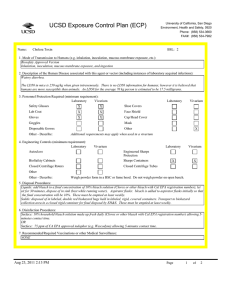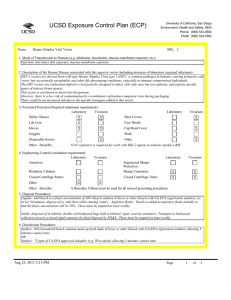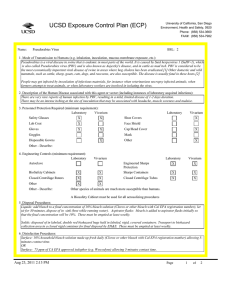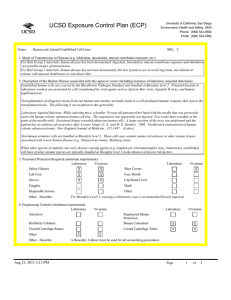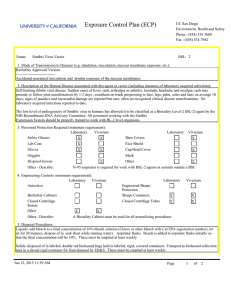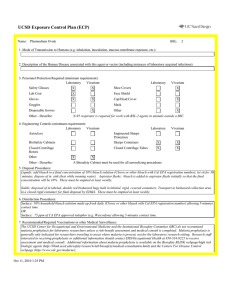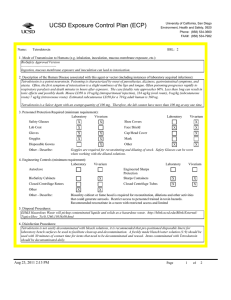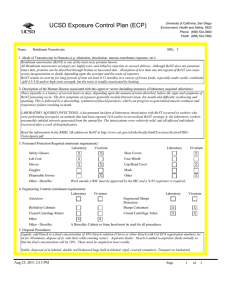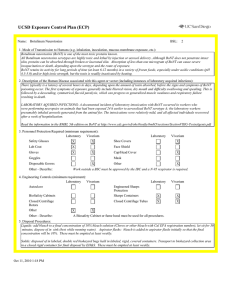UCSD Exposure Control Plan (ECP)
advertisement
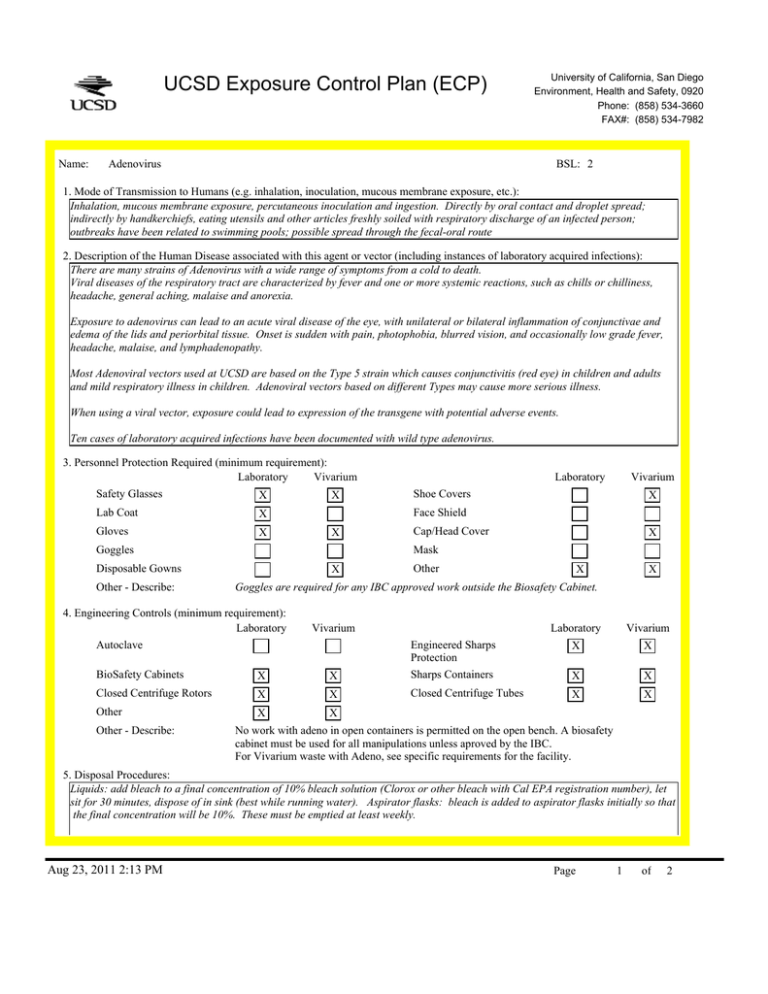
UCSD Exposure Control Plan (ECP) Name: Adenovirus University of California, San Diego Environment, Health and Safety, 0920 Phone: (858) 534-3660 FAX#: (858) 534-7982 BSL: 2 1. Mode of Transmission to Humans (e.g. inhalation, inoculation, mucous membrane exposure, etc.): Inhalation, mucous membrane exposure, percutaneous inoculation and ingestion. Directly by oral contact and droplet spread; indirectly by handkerchiefs, eating utensils and other articles freshly soiled with respiratory discharge of an infected person; outbreaks have been related to swimming pools; possible spread through the fecal-oral route 2. Description of the Human Disease associated with this agent or vector (including instances of laboratory acquired infections): There are many strains of Adenovirus with a wide range of symptoms from a cold to death. Viral diseases of the respiratory tract are characterized by fever and one or more systemic reactions, such as chills or chilliness, headache, general aching, malaise and anorexia. Exposure to adenovirus can lead to an acute viral disease of the eye, with unilateral or bilateral inflammation of conjunctivae and edema of the lids and periorbital tissue. Onset is sudden with pain, photophobia, blurred vision, and occasionally low grade fever, headache, malaise, and lymphadenopathy. Most Adenoviral vectors used at UCSD are based on the Type 5 strain which causes conjunctivitis (red eye) in children and adults and mild respiratory illness in children. Adenoviral vectors based on different Types may cause more serious illness. When using a viral vector, exposure could lead to expression of the transgene with potential adverse events. Ten cases of laboratory acquired infections have been documented with wild type adenovirus. 3. Personnel Protection Required (minimum requirement): Laboratory Vivarium Safety Glasses X X Lab Coat X Gloves X X X Cap/Head Cover X X Other X X Goggles are required for any IBC approved work outside the Biosafety Cabinet. 4. Engineering Controls (minimum requirement): Laboratory Autoclave X Vivarium Laboratory Vivarium X X X Engineered Sharps Protection Sharps Containers X X Closed Centrifuge Tubes X X Closed Centrifuge Rotors X X Other X X Other - Describe: Shoe Covers Mask Disposable Gowns BioSafety Cabinets Vivarium Face Shield Goggles Other - Describe: Laboratory No work with adeno in open containers is permitted on the open bench. A biosafety cabinet must be used for all manipulations unless aproved by the IBC. For Vivarium waste with Adeno, see specific requirements for the facility. 5. Disposal Procedures: Liquids: add bleach to a final concentration of 10% bleach solution (Clorox or other bleach with Cal EPA registration number), let sit for 30 minutes, dispose of in sink (best while running water). Aspirator flasks: bleach is added to aspirator flasks initially so that the final concentration will be 10%. These must be emptied at least weekly. Aug 23, 2011 2:13 PM Page 1 of 2 UCSD Exposure Control Plan (ECP) Solids: disposed of in labeled, double red biohazard bags held in labeled, rigid, covered containers. Transport to biohazard collection area in a closed rigid container for final disposal by EH&S. These must be emptied at least weekly. 6. Disinfection Procedures: Surface: 10% household bleach solution made up fresh daily (Clorox or other bleach with Cal EPA registration number) allowing 5minutes contact time. 70% EtOH is not an approved disinfectant for Adenovirus and is not effective. OR Surface: 75 ppm of CA EPA approved iodophor (e.g. Wescodyne) allowing 5-minutes contact time. 7. Recommended/Required Vaccinations or other Medical Surveillance: None 8. Employee Exposures- first aid procedures: a. Eye exposure from splash or aerosols - rinse a minimum of 15 minutes in eye wash or flush area with water. b. Skin exposure - wash area with soap and water for 15 minutes c. Needle stick and/or sharps exposure - wash wound area with soap and water for 15 minutes d. Contamination of clothing - remove the contaminated clothing and place in biohazard bag, shower with the emergency douse shower, and put on clean clothes. e. Spill or release - Monday through Friday, 8a - 4:30p call EH&S (858-534-3660); after hours call UCSD Police (858-534-4357) 9. Employee Exposure - seek medical follow-up from the following medical providers: (TAKE THIS ECP WITH YOU) 24-hour walk-in service: Thornton Hospital Emergency Room, (858) 657-7600 UCSD Medical Center (Hillcrest) Emergency Room, (619)543-6400 If medical follow-up is required, Monday - Friday, 8a - 4:30p: UCSD Occupational & Environmental Medicine, (619)471-9210 10. Report All Injuries, Illnesses, and Exposures to EH&S: Complete the information found on "What to Do if a Work-Related Injury, Illness, or Exposure Occurs" (http://blink.ucsd.edu/Blink/ External/Topics/How_To/0,1260,4295,00.html) 11. Required Biosafety Training: 1) Laboratory specific training on hazards, exposure evaluations, and the required precautions for experimental procedures used with this agent - provided by Principle Investigator 2) The UCSD Viral Vector class is required before using Adenoviral vectors. 3) All users of Adenovirus or its vectors must read and understand this ECP. 12. Lab specific instructions: Procedure listed in protocol S02174R. Biohazard sign required, cage card lists hazardous agent, protective equipment (latex gloves, mask (N95), disposable lab coat, goggles, hair net, footcovers, etc.), use of biological safety cabinet, and proper disposal of contaminated tools and equipment used. Aug 23, 2011 2:13 PM Page 2 of 2
